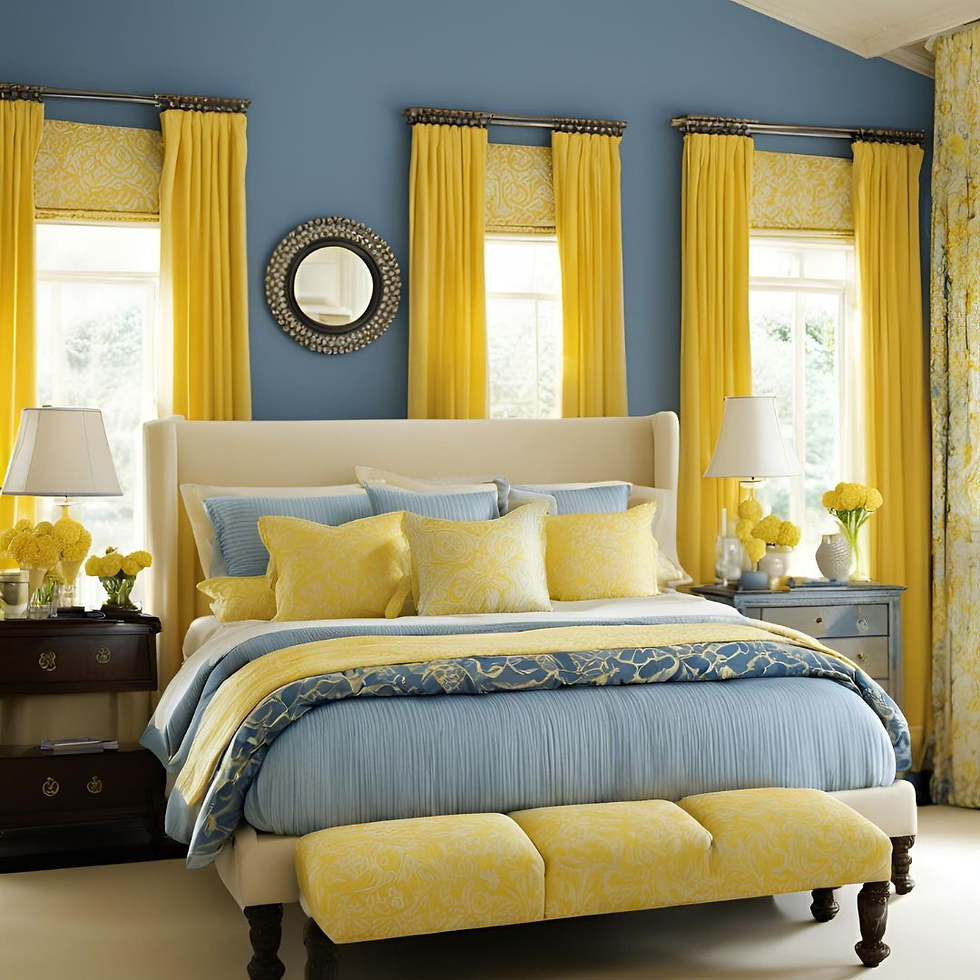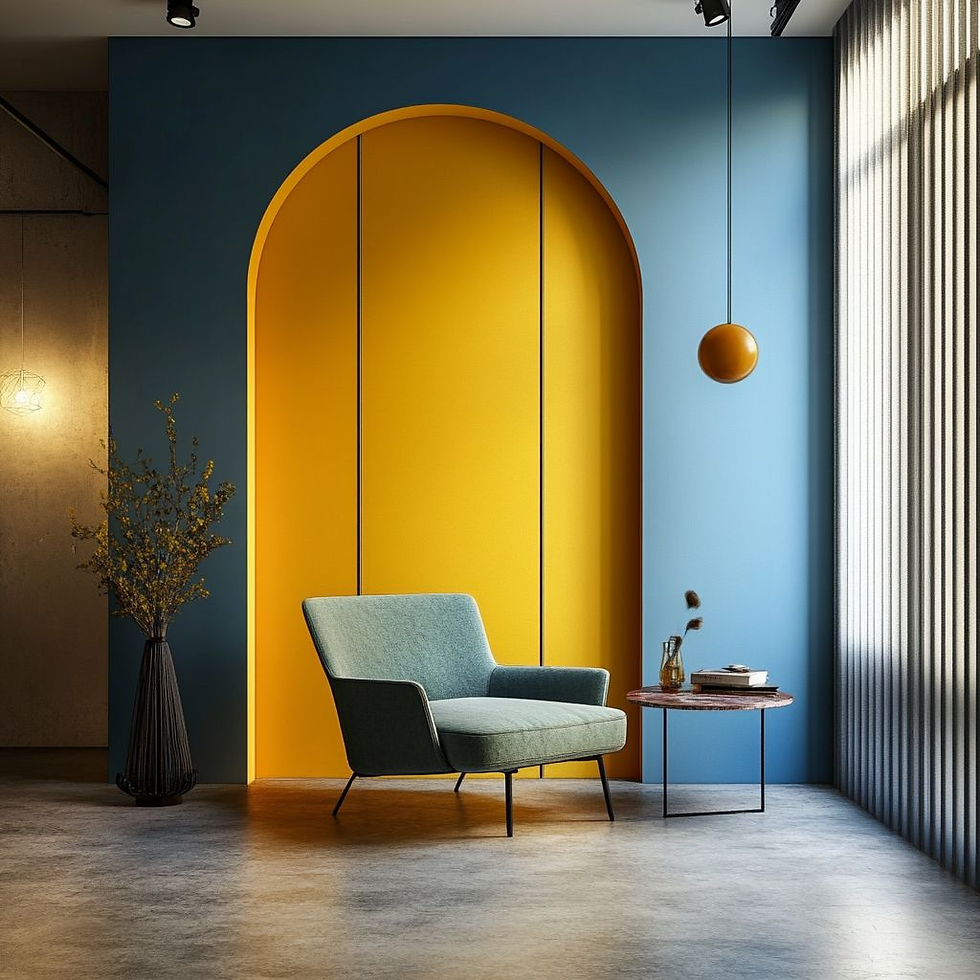
Before diving into the design process, it's crucial to understand the psychology behind these colors. Blue is often associated with calmness, serenity, and trust. It's the color of the sky and sea, which can invoke feelings of peace and stability. On the other hand, yellow is linked to happiness, energy, and warmth. It represents the sun and can bring optimism and cheerfulness to a space.
The Calming Influence of Blue
Blue is known for its calming properties, making it ideal for spaces where relaxation is the goal. The presence of blue can lower heart rates and reduce stress, making it perfect for bedrooms and bathrooms. In offices, blue can enhance focus and productivity, providing a tranquil environment that promotes efficiency.
The Energizing Nature of Yellow
Yellow, with its vibrant and energetic nature, can uplift moods and create a welcoming atmosphere. It’s an excellent choice for social areas like kitchens and dining rooms where it encourages interaction and conversation. Yellow can also stimulate mental activity, making it suitable for creative spaces such as studios or children's play areas.
Achieving Balance with Blue and Yellow
When combined, blue and yellow create a balanced environment that blends tranquility with energy. The coolness of blue can counterbalance the warmth of yellow, creating a space that feels both inviting and peaceful. This balance can be tailored to fit any room by adjusting the intensity and proportion of each color.
Choosing the Right Shades

Not all blues and yellows are created equal. The key to a successful blue and yellow interior design is selecting the right shades that complement each other and align with the desired mood of the room.
Cool Blues and Soft Yellows
For a relaxing and gentle atmosphere, consider using cool blues such as baby blue or sky blue paired with soft yellows like pastel or buttercup. This combination works well in bedrooms, nurseries, or any space where you want to promote relaxation and comfort. Cool blues can create a sense of spaciousness, while soft yellows can add a touch of warmth without overwhelming the senses.
Bold Blues and Vibrant Yellows
If you're looking to make a statement, opt for bolder shades like navy or royal blue with vibrant yellows such as lemon or mustard. This dynamic pairing can add energy and drama to living rooms, kitchens, or dining areas. It's perfect for spaces where you want to encourage conversation and activity. Bold blues can ground a space, while vibrant yellows can act as focal points that draw attention and add excitement.
Modern Combinations
For a modern twist, try pairing a muted or dusty blue with a mustard or ochre yellow. These combinations are on-trend and can give your space a contemporary edge. This approach works well in minimalist designs, offering a pop of color without overwhelming the senses. The subtlety of muted blues can offer a sophisticated backdrop, while deeper yellows can inject personality and style.
Customizing Shades for Personal Style
Consider your personal style and the overall theme of your home when choosing shades. If you prefer a coastal vibe, light and airy blues with sunshine yellows can capture that feel. For a more urban look, industrial blues paired with bold yellows can create a chic, metropolitan atmosphere. Tailoring your color choices ensures that your space reflects your unique taste and lifestyle.
Applying Blue and Yellow in Different Spaces

Living Room
In the living room, blue and yellow can create a lively yet cozy setting. Use a blue sofa as a focal point and accessorize with yellow throw pillows or a yellow rug. Alternatively, paint the walls a soft blue and add yellow accents through artwork or decorative pieces. This can create a layered look that is both inviting and stylish, perfect for entertaining guests or relaxing with family.
Kitchen
The kitchen is an excellent place to experiment with color. Consider blue cabinetry paired with yellow backsplash tiles. This combination not only adds a cheerful touch but can also make the kitchen feel more inviting and warm. Open shelving with blue dishes and yellow kitchen gadgets can add subtle color pops, creating an engaging and functional culinary space.
Bedroom
For a serene bedroom, choose a light blue for the walls and incorporate yellow through bedding or curtains. This setup promotes restfulness while adding a cheerful touch to start your day on a positive note. Blue accent walls can create depth, while yellow can be introduced through bedside lamps or artwork to maintain a balanced and harmonious environment.
Bathroom
In the bathroom, blue and yellow can evoke a spa-like feel. Opt for blue tiles and add yellow through bath towels or a shower curtain. This combination can make the space feel clean and refreshing. Adding blue glass accessories or yellow scented candles can enhance the mood, transforming the bathroom into a relaxing retreat.
Outdoor Spaces
Don’t forget about outdoor spaces when using blue and yellow. A blue patio set with yellow cushions can create a vibrant and welcoming outdoor area. Blue planters with yellow flowers can add a touch of nature-inspired elegance, making your garden or balcony an extension of your home's interior design.
Balancing the Elements

While blue and yellow are the stars, it's important to balance them with neutral elements. Whites, grays, and browns can help ground the color scheme and prevent it from becoming overwhelming.
Neutral Backdrops
Use neutral colors for larger surfaces like walls or floors. This allows blue and yellow accents to shine without clashing. For instance, a white or light gray wall can provide a perfect backdrop for blue and yellow furnishings. Neutral tones can also add a sense of calm and continuity throughout the space, ensuring that the vibrant colors do not overpower the room.
Natural Materials
Incorporate natural materials like wood, stone, or rattan to add texture and warmth. Wooden furniture or stone countertops can complement the blue and yellow palette while enhancing the overall design. Natural elements bring a sense of earthiness and balance, making the space feel more grounded and harmonious.
Layering with Fabrics
Layering different fabrics in your design can also help balance the colors. Consider blue and yellow textiles in various patterns and textures, such as throws, curtains, or upholstery. This adds depth and interest, preventing the room from feeling flat or one-dimensional, and helping to tie together the overall design scheme.
The Role of Lighting
Lighting plays a critical role in how colors are perceived. Natural light can enhance the vibrancy of blue and yellow, while artificial lighting can be used to soften or highlight certain areas. Choose lighting fixtures that complement your color palette, such as a blue lampshade or a yellow pendant light, to enhance the mood and functionality of the space.
Accessorizing with Blue and Yellow

Accessories are a great way to introduce blue and yellow into your space without committing to a full redesign. Consider the following ideas:
Throw Pillows
Mix and match blue and yellow pillows on sofas or beds for a quick update. This is an easy and cost-effective way to refresh your space. Experiment with different sizes, shapes, and patterns to create visual interest and enhance the comfort of your seating areas.
Artwork
Choose art pieces that feature blue and yellow to tie the room together. Art can act as a focal point, drawing the eye and reinforcing your color scheme. Look for paintings, prints, or photographs that incorporate these colors to add personality and style to your walls.
Vases and Planters
Incorporate blue and yellow vases or planters with greenery to add life to your space. These elements can bring a touch of nature indoors, creating a fresh and inviting atmosphere. Consider varying the heights and shapes of your vases and planters for a dynamic display that enhances your decor.
Rugs
A blue or yellow rug can anchor a room and define the area. Rugs are versatile accessories that can introduce color, pattern, and texture to a space. Choose a rug that complements your existing decor and provides a comfortable and stylish foundation for your room.
Seasonal Decor
Switching up your accessories with the seasons can keep your space feeling fresh and relevant. In the spring and summer, opt for lighter, brighter shades of blue and yellow. For fall and winter, choose deeper, richer tones to create a cozy and warm environment.
Tips for Success
Start Small
If you're hesitant, start with small accessories and gradually add more blue and yellow elements. This approach allows you to test your color scheme without a significant commitment. As you become more comfortable, you can introduce larger items or more permanent changes.
Consistency is Key
Ensure that the shades of blue and yellow are consistent throughout the space for a cohesive look. This doesn't mean every item has to be the same color, but they should complement each other and work together harmoniously. Consistency in color can create a unified and polished appearance.
Balance with Neutrals
Use neutral colors to balance the vibrancy of blue and yellow. Neutrals can act as a canvas, allowing the brighter colors to stand out without overwhelming the space. Incorporate these tones through furniture, flooring, and large surfaces to maintain a balanced and sophisticated look.
Layer Textures
Mix different textures to add depth and interest to the design. Combining smooth, rough, shiny, and matte surfaces can create a rich and engaging environment. Textural contrast can highlight your color choices and bring a sense of dimension and complexity to the room.
Personal Touches
Incorporate elements that reflect your personality and preferences. Whether it's a vintage blue vase from a market or a custom yellow artwork, personal touches can make the space feel uniquely yours. These additions add character and tell your story through design.
Conclusion : Blue & Yellow Interior Design
Blue and yellow interior design offers a versatile and dynamic approach to decorating your home. By understanding color psychology, choosing the right shades, and balancing with neutrals, you can create a harmonious and inviting space that reflects your personality. Whether you're aiming for a vibrant living area or a calming bedroom retreat, the combination of blue and yellow can help you achieve your design goals with style and flair.
Embrace the power of color and let your creativity shine through your home with the timeless elegance of blue and yellow. This classic duo can transform your living space into an oasis of tranquility and vibrancy, showcasing the best of both worlds and offering endless possibilities for expression and enjoyment.